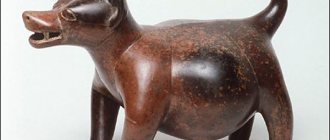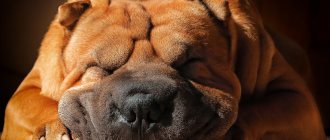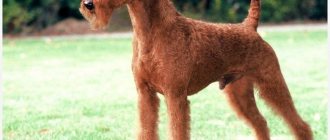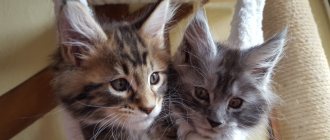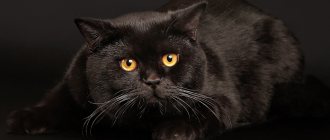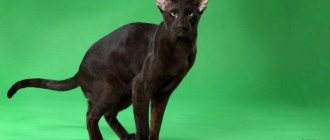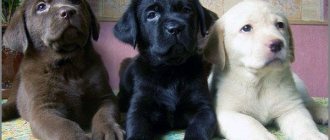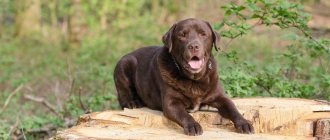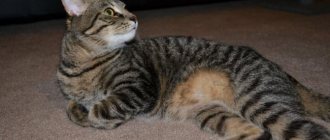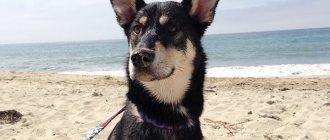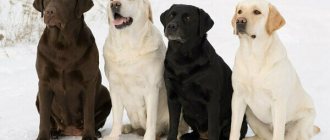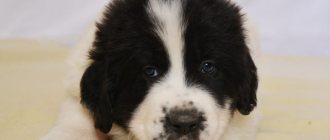Origin of the Labrador breed
The Labrador breed, according to statistics released by the American Kennel Club, is one of the four most popular dog breeds in the world.
One of the reasons for this popularity is the combination of all the best characteristics of a hunting dog in the breed. Labradors are able to move quickly both on land and in water, which is greatly facilitated by their short hair, which offers little resistance to water. The Labrador dog breed is distinguished by a unique, sensitive sense of smell, allowing dogs to sense game through a dense layer of earth. The character traits of Labradors include hard work and the ability to work in a team, not only of Labradors, but also of dogs of other breeds. Labradors are excellent hunters, rushing to find shot game, unlike, for example, pointers. Various sources of information suggest that the Labrador breed originates from the St. John's Newfoundland dogs and, despite the similarity of names, is not directly related to the geographical area of Labrador. The dog breed first gained popularity in England, where it came from Newfoundland on fishing boats delivering cod to Dorset. The description of the Labrador breed, compiled at that time, speaks of the presence of a certain membrane between the toes of the Labrador's paws, thanks to which the dog could stay in sea water for a long time, as well as short hair and an otter-like tail. By the way, this exact description of the tail can still be found in the AKS standard.
However, despite the supposed origins from Newfoundland, it is still not known exactly how the Labrador dog breed developed, where it came from in this area, and how its development took place. There is an assumption that the Labrador breed was specially bred by Newfoundland fishermen for search and rescue work in shipwrecks.
This version is also shared by Major Maurice Portal, author of the book “Hunting at Home and Abroad.” In order to get such dogs, they crossed a pointer and a black Newfoundland retriever. From this mixture came a strong, hardy dog with short black hair. Moreover, according to Major Maurice Portal, if the crossing had continued along the blood line, the Labrador dog breed would have been distinguished by lightness of bones, long legs and tail, and would have ears similar to pointers.
In addition to the St. John's dogs, Newfoundlands were credited with developing three more breeds of dogs, each of which could theoretically be the ancestor of the Labrador breed, however, given the inconsistencies in the characters, physical capabilities and constitution of the described breeds and Labradors, the origin of Labradors is most likely from the St. John's dogs. This breed is closest to modern Labrador Retrievers.
Another description of the St. John's breed, compiled in 1814, is found in Peter Hawker. It is very similar to the description of the Labrador breed that we know today. Not only the physiological parameters are the same, but also the psychological characteristics of the Labrador breed. The second breed he described, to which he gave the name “real Labrador,” according to Hawker, was distinguished by a large build, strong paws, a small head, hard short hair and a high vertical tail. According to Hawker's description, these dogs were distinguished by high endurance and good physical abilities - they were used to deliver sleighs with firewood to the shore line.
The third Newfoundland dog breed had a relatively small build and resembled a Pointer. These dogs had an elongated muzzle, a deep chest and thin legs, hair that was either smooth, like Labradors, or short, and a straight tail that did not curl towards the back. An important part of the descriptions compiled by Hawker is an indication of a characteristic feature of Labradors - high mobility, both on land and in water. This indication helps determine the origin of Labradors from St. John's dogs. Also, according to Hawker, the dogs had an excellent sense of smell and the ability to find prey in any terrain.
The characteristics of the Labrador breed coincide with the Hawker's description of St. John's dogs in at least two main ways. It is also noteworthy that other contemporaries of Hawker agreed with his characteristics given to the two Newfoundland breeds of large and smaller dogs.
Another contemporary of Hawker, Yot, dedicated a book to Newfoundland dogs. In his opinion, Newfoundlands were used as retrievers for the purpose of searching for shot game. The main place in his work is occupied by St. John's dogs. The author describes them as large dogs with an excellent sense of smell. Yot also emphasizes the dogs’ agility, readiness to search for game and endurance, which manifests itself regardless of the landscape and weather, as well as the Sand Jones breed’s ability to participate in hunting with pointers, without fighting for territory.
Contemporary publications and scientific works seeking to determine the characteristics and origins of Labradors often mention the characteristics presented in Hawker's book, especially such traits as agility, pliability and a unique sense of smell. Such characteristics allow us to speak of Labradors as natural-born retrievers, occupying a special place among other hunting dogs.
Maintenance and care
When keeping a Labrador in your home, you should pay attention to some points:
- If not fed correctly, Labradors can quickly gain excess weight. A small puppy is fed 6 times a day, a puppy aged 6 months is fed 3 times a day. When feeding a puppy natural food, feed the puppy soups with meat broth, liquid porridge with milk, give him lean meat, cottage cheese and vegetables. An adult Labrador is fed 2 times a day. His diet includes boiled meat, cereals, fermented milk products, and fresh vegetables can be given in summer.
- Labradors are very active dogs, they love movement. An adult Labrador needs to be walked twice a day: at least half an hour in the morning and two hours in the evening. Adult Labradors need long walks, otherwise, without good physical activity, they splash out their irrepressible energy on pranks and hooliganism. Labrador puppies require extensive play and training sessions.
- The Labrador's thick, waterproof coat does not require special care; combing and brushing 1-2 times a week is sufficient. During the molting period, the amount of scratching is doubled. You need to bathe your Labrador when it gets dirty.
- Labrador's ears, like other dog breeds with floppy ears, require regular inspection for the presence of ear parasites and cleaning of dirt that accumulates there. Labradors are susceptible to otitis, including infectious ones, so do not neglect ear care.
Any difficulties of keeping a Labrador in your home are more than compensated by the joy that these dogs bring to their owners.
History of Labradors in England
In the 20s of the 19th century, Labradors spread to England. A large role in this was played by the famous breeder, Malmesbury II, who discovered a dog of the St. John's breed on his property. The St. Johns breed owes its purity to him and Malmesbury III - for several years, breeders bred St. Johns retrievers and did not allow them to mix with other dogs. In one of his letters, Malmesbury states that he bred and crossed only those dogs that first came to England from Newfoundland.
However, not all breeders of that time were so scrupulous about the purity of the St. John's breed. There were objective reasons for this: high taxes and unfavorable quarantine conditions for newly arrived dogs. As a result, the importation of purebreds from Newfoundland ceased, and the St. John's breed began to degenerate. According to some evidence, breeders of the breed tried to restore it by resorting to outcrossing on pointers and setters.
Thus, attempts to restore the purity of the breed led to the creation of the first standard. A significant role in this was played by the family of the Dukes of Buccleuch, true adherents of the breed, who were breeding Labradors in Scotland. Buccleuch kept records of the breeding origins of their dogs with an accuracy and scrupulousness worthy of respect. It was these records that subsequently served as material for studying the pedigree of Labradors and made it possible to determine the Malmesbury dog breed. In particular, thanks to Buccleuch's careful records, two dogs with impeccable pedigree were identified - Flapper and Peter, owned by Major Portal and A.K. Butteru from Faskalli. Flapper and Peter are recognized as the founders of the modern Labrador breed, officially recognized by the Kennel Club of England.
Another 13 years later, Countess Lorna Howe gave birth to the Labrador Club. The Countess herself kept a large number of Labradors at Benchory Kennels. Many of her pets were winners of prestigious Crufts shows. Countess Howe was not one of the active breeders, however, she was a true supporter of the Labrador breed and enjoyed the reputation of a connoisseur.
Development of the Labrador breed in America
Americans began importing Labradors into the country even before the First World War. This amazing breed quickly gained popularity, however, despite its outstanding qualities, it was classified by the American Kennel Club in the general category of retrievers, as happened in England.
The Labrador breed became very popular among wealthy people involved in sports shooting. These were mainly residents of Long Island, seeking to inherit the habits and way of life of the English nobility. They brought dogs from Scotland, along with breeders and experienced huntsmen. The peak of activity of families of the so-called Gold Coast came in the 20s and 30s of the last century. Active participants in the exhibitions included dogs belonging to the Phipps, Morgans, Marshall Field, Whitney, Belionts, Wilton Lloyd Smith and many other celebrities. Thus, J.P. Morgan was the owner of a fawn Labrador, Banchory Show, originally from England, who brought him slippers every evening. According to Joan Reed, Banchory Shaw was the first American fawn Labrador.
Labradors received official status as a separate breed in America only in the late 20s of the last century. And in 1930, breeders from Long Island organized the American Labrador Retriever Club, whose charter is still in effect in New York. The club's first president was Marshall Field. He stayed in this position for 4 years: from 1931 to 1935.
His wife brought an experienced trainer and huntsman, Douglas Marshall, from Scotland, who put a lot of effort into raising champion Labradors. Subsequently, his work was continued by his children - Dolly and Bob Marshall. Douglas's daughter, Dolly Marshall, was the first female professional trainer. She worked at the West Island Nursery, owned by the Morgan family.
The first vice presidents of the Labrador Retriever Club of America were Franklin B. Lord and Robert Gelet. Also included in the club were such well-known and respected breeders as Paul J. Pennoyer, Charles Lowpens, William J. Hutchinson, J. F. Carlisle, Alfred Ely, Benjamin Moore, Auguts Belmont and W. Avrell Harriman. The latter, Avrell Harriman, was not only an enthusiast of the breed, but also occupied a prominent place in society - he served as governor of the city of New York and was the US ambassador.
Another Scot, James Cowie, who came to the states as assistant gamekeeper Tom Briggs, was not only the first Scottish Jew in the United States, but also a first-class trainer and later a respected breed expert. James Cowie worked in New York, on the Harrymann's Arden estate. One of his students, Earlsmoor Moorof Arden, repeatedly became the winner of various competitions and exhibitions.
The beginning of the last century in America was a golden time for the Labrador breed. The breeders, as a rule, were wealthy nobles, had vast lands, and were actively involved in sports, including hunting. Their pets could naturally develop all the necessary skills for both field competition and the show ring. Participation in such events was considered a privilege of the nobility. According to Joan Reed, at that time a clear distance was maintained between huntsmen, trainers and dog owners.
However, the time for the diversified development of the Labrador breed's skills gradually passed. Breeders and trainers began to focus their attention on specific types of competition. Preparing for each of them required a lot of effort and time, so I had to choose a profile for future competitions. Also, breeders had to travel a lot with their pets, which helped reduce training time. As a result, breeders were faced with a choice between two types of competitions - field trials or exhibitions. Thus, for a long time representatives of the Labrador breed did not become double champions, participating in only one type of competition.
Fortunately, recently a reverse stable trend has emerged. Breeders have again begun to show interest in various competitions, which means that modern Labradors have a chance to once again regain the glory of a multidisciplinary breed.
Advantages and disadvantages
Advantages of Labrador
The Labrador has a huge number of advantages that have made this dog breed so popular all over the world:
- Balanced psyche
- Boundless devotion to the owner and his family
- Kindness towards people and animals
- Calm attitude towards other pets, including cats and other dogs
- Short hair requires virtually no maintenance
Disadvantages of Labrador
With all the advantages of Labradors, they also have small disadvantages:
- Labrador is a dog that requires walking and good physical activity, regardless of the time of year and weather conditions.
- A friendly attitude towards everyone, including strangers, does not allow one to consider a Labrador a good watchman
Characteristics of the Labrador breed
As mentioned above, the nature of each breed is determined by its purpose. Also, the essence of the Labrador is largely determined by the work and the qualities necessary for its implementation, which fishermen entrusted to the dogs.
Newfoundland fishermen needed a good hunting dog that was not picky about food and could eat fish. This dog had to be able to find game and bring it to the hunter, but the main thing was to carry heavy loads and work in water. All these tasks were only possible for dogs with a specific constitution and coarse hair.
Its main features are physical strength, endurance, athletic physique and - an obligatory component! - affection and desire to serve the owner. Such dogs were often sent to retrieve fish that had slipped out of nets into water or onto ice, so tough hair and agility were also very important. In addition, a prerequisite for a dog’s survival in such conditions was a strong bone structure, otherwise the animal could simply break its legs getting out of the boat onto the rocky shore.
The small Newfoundland, a breed of small but tenacious and agile dogs, met all these criteria perfectly. This name is most suitable for the Labrador, and if it had stuck, perhaps much of the controversy about the variety of Labrador types could have been avoided. The Labrador dog breed is perfectly defined by the short description “small Newfoundland with short hair.”
Who is the breed suitable for?
- Owners of a country house or dacha consisting of a house and a grass lawn. Fresh air, grass and plenty of free space are paradise for a Labrador. He will be able to run around the site having fun, without the risk of ruining anything.
- Active families with teenage children. Families who love active outdoor recreation, sports walks, hiking, cycling and water recreation - this is the best thing you can think of for a Labrador. And with older children, dogs quickly find a common language, can play with them for a long time, and follow their commands.
- Energetic seniors. Labrador is most suitable for energetic and relatively healthy retirees. Dogs need constant contact with humans - a pensioner does not go to work. Older people need walks in the fresh air - dogs will be happy to keep them company. The only condition is that the dog must undergo a training course so that it can be easily controlled.
Labrador color genes
The first Labradors, despite all the similarities with modern purebred dogs, still had some differences. For example, some dogs might have longer fur than the current standard, or white spots on their paws, or even a large spot on their chest. Such manifestations are the consequences of early genetic mixtures of the breed, and do not at all indicate impure blood.
Pigment spots of excellent color appear from time to time in modern Labradors, although the description of the Labrador breed does not always mention them. For example, it is quite common to find puppies of all colors with white pigment spots. Less commonly, you can find a black or chocolate Labrador with fawn spots on the paws, or a fawn with black markings. However, this phenomenon does occur. Breeders call puppies with o (from English - in splashes, splashed), because the pigment spots really resemble drops of paint or dirt.
Let us repeat once again - the presence of such marks does not at all indicate any mixture or bad breed type of Labrador. These dogs have the same constitution, character and abilities as the same-color Labradors. The only thing that is inaccessible to such a dog is participation in exhibitions. Although, according to the breed standard, a small amount of white hair on the hind legs, belly or a small white spot on the chest is not penalized, although it is undesirable.
Officially
Labradors were recognized as a separate breed in England only in 1904; before that they were classified under the general category of retrievers. The Labrador dog breed was very popular. Representatives of the breed won at exhibitions and in field trials. Five years later, in 1909, the Labrador Retriever Club was founded in England. Another seven years later - in 1916. — the first English breed standard was approved.
At the prestigious English Crufts competition, the cable named Bramshaw Bob became champion twice - in 1932 and 1933. His victory helped to consolidate the fame and high popularity of the breed. Brahamshaw Bob belonged to the Banchory kennel, founded by the famous breeder and connoisseur of the breed, Countess LornaHoof.
At first, despite the periodic appearance of sandy (chocolate) and fawn-colored dogs, preference was given to black dogs. The fact that unpopular types of colors have been preserved, the Labrador breed owes a great deal to the first English kennels that bred dogs of white, cream and red colors. In particular, this is the Knaith nursery, owned by Veronica Wormald, many of whose pets became champions of various exhibitions. Veronica Wormald also became the founder of the English Club of Fawn Labrador Retrievers.
The situation was worse with chocolate (sand) colored Labradors. They began to gain popularity only a few years after the fawn Labradors, and were the last to be recognized as true representatives of the breed. But today this color is one of the most popular. It is curious that the first Labrador to come to America was a chocolate-colored dog named Buddy.
How much does a Labrador Retriever puppy cost?
The appropriate age for selling a puppy is 1.5 months. No self-respecting breeder will offer offspring that have not reached this age. The cost of a purebred puppy with a kennel mark, pedigree and all the necessary documents varies from 30,000 to 65,000 rubles. Naturally, the price depends on the class of the dog.
You can purchase a purebred puppy, but without a puppy card, for 10,000-12,000 rubles. Puppies offered much cheaper in private advertisements are a real “pig in a poke” and no guarantees can be obtained about their belonging to the breed.
The Labrador Retriever is an ideal dog for a large, friendly family. He will treat everyone, without exception, family members well. However, such a pet needs attention, care and love.
Labrador dog breed - history in chronological order
The beginning of the 19th century - the arrival of the first dogs of the St. John breed in England, the import of the breed by the Earl of Malmesbury II representatives of the breed in Heron Cot, near Poole.
- 1814 - "Instructions for Young Hunters" by Colonel Peter Hawker - the first mention of Newfoundland Labradors.
- 1823 - painting by Edward Landisre “Bark. Female Labrador,” depicting a black dog with white spots.
- 1835 - In Scotland, the Duke of Buccleuch the Fifth opens a kennel for dogs of the St. John breed.
- 1839 - in a letter from the Duke of Buccleuch, his dog Moss and a dog named Drake, owned by the Earl of Home, are called Labradors.
- 1870 - the name Labrador Retriever was assigned to Labradors in England.
- 1882 - 6 Malmesbury III Labradors are sent to Scotland to the Duke of Buccleuch the Fifth and Earl Howe the Seventh, in order to preserve the breed.
- 1885 - The Newfoundland Sheep Protection Act is issued, a quarantine is declared in England and the fishing trade is reduced, as a result, the import of dogs from Newfoundland decreases.
- 1887 - The Earl of Malmesbury the Third writes a letter to the Duke of Buccleuch, in which he points out that in his kennel the dogs have always been called Labradors and have maintained the purity of their breed from the first dog brought from Poole. He also gives a short description of the breed, pointing to the specific water-repellent coat and otter tail of Labradors.
- 1892 - birth of two “liver-colored” (chocolate) Labradors in the Buccleuch kennel.
- 1899 - written mention of the birth of the first yellow Labrador named Benof Hyde in Major Radcliffe's kennel.
- 1903 - recognition of the breed by the English Kennel Club.
The beginning of the 20th century marked the beginning of active imports of Labradors into the United States.
- 1916 - the creation of the English Labrador Club through the efforts of Lord Knutsford and Countess Howe, who ran the Munden and Banchory kennels.
- 1917 - registration of the first Labradors with the Kennel Club of America.
- 1931 - registration of the Labrador Retriever Club in America, conducting the first field tests.
- 1930 - Dog field testing clubs spread throughout the United States.
- 1933 - in New York, under the judgeship of Mrs. Marshall Field, the first exhibition was held, at which only Labradors were presented. Late 1930s - the first chocolate-colored Labradors appear in the Tibshelfs and Cookridge kennels.
- 1938 - A Labrador appeared on the cover of Life magazine for the first time - a black dog named Blindof Arden, owned by Avirell Harriman. This year, Blindof Arden became the champion in the retriever competition.
- 1941 - The National Retriever Club is founded in the States.
- The 40s-50s of the 20th century were the peak of popularity of the Labrador breed in the USA, caused by socio-political and economic changes in the country.
- 1959 - A dog, a black Labrador King Buck, is depicted on a US postage stamp for the first time.
- 1991 - The Labrador breed takes first place in the registration of the American Kennel Club.
